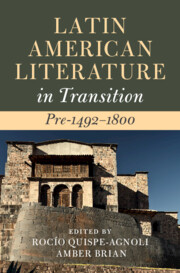Book contents
- Latin American Literature in Transition Pre-1492–1800
- Latin American Literature in Transition
- Latin American Literature in Transition Pre-1492–1800
- Copyright page
- Dedication
- Contents
- Figures
- Contributors
- Acknowledgments
- Introduction Dwelling in Transitions
- Part I Land, Space, Territory
- Part II Body
- Part III Belief Systems
- Chapter 9 The Flood Story in the Huarochirí Manuscript and Other Early Colonial Andean Texts
- Chapter 10 Idol or Martyr: Sacredness and Symbol in the Religiosity of the Indies
- Chapter 11 Creole Religiosity in Colonial Mexico: Devotional Cultures in Transition
- Chapter 12 The Empire Beyond Spanish America: Spanish Augustinians in the Pacific World, 1680–1724
- Chapter 13 Indigenous Peoples and Catholicism in Eighteenth-Century Mexico City
- Part IV Literacies
- Part V Languages
- Part VI Identities
- Index
- References
Chapter 12 - The Empire Beyond Spanish America: Spanish Augustinians in the Pacific World, 1680–1724
from Part III - Belief Systems
Published online by Cambridge University Press: 25 November 2022
- Latin American Literature in Transition Pre-1492–1800
- Latin American Literature in Transition
- Latin American Literature in Transition Pre-1492–1800
- Copyright page
- Dedication
- Contents
- Figures
- Contributors
- Acknowledgments
- Introduction Dwelling in Transitions
- Part I Land, Space, Territory
- Part II Body
- Part III Belief Systems
- Chapter 9 The Flood Story in the Huarochirí Manuscript and Other Early Colonial Andean Texts
- Chapter 10 Idol or Martyr: Sacredness and Symbol in the Religiosity of the Indies
- Chapter 11 Creole Religiosity in Colonial Mexico: Devotional Cultures in Transition
- Chapter 12 The Empire Beyond Spanish America: Spanish Augustinians in the Pacific World, 1680–1724
- Chapter 13 Indigenous Peoples and Catholicism in Eighteenth-Century Mexico City
- Part IV Literacies
- Part V Languages
- Part VI Identities
- Index
- References
Summary
This chapter brings into focus the Spanish Augustinian missionaries who, from their operational base in Manila, Philippines, attempted to establish an apostolic presence in southern China in the late 1680s and early 1700s. Their testimonies render an intimate, first-hand insight into the physical and economic penuries of the missionaries; the attitudes of the Augustinian order towards foreign cultures; the administrative and political difficulties they encountered; the adaptation to local circumstances of the missionaries’ education and operational experience acquired prior to passing to China; and the role of the Philippines and New Spain as an essential lifeline and as a crossroads of communication between China and the rest of the Spanish empire.
Keywords
- Type
- Chapter
- Information
- Latin American Literature in Transition Pre-1492–1800 , pp. 180 - 194Publisher: Cambridge University PressPrint publication year: 2022



